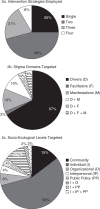A systematic review of interventions to reduce HIV-related stigma and discrimination from 2002 to 2013: how far have we come?
- PMID: 24242268
- PMCID: PMC3833106
- DOI: 10.7448/IAS.16.3.18734
A systematic review of interventions to reduce HIV-related stigma and discrimination from 2002 to 2013: how far have we come?
Abstract
Introduction: HIV-related stigma and discrimination continue to hamper efforts to prevent new infections and engage people in HIV treatment, care and support programmes. The identification of effective interventions to reduce stigma and discrimination that can be integrated into national responses is crucial to the success of the global AIDS response.
Methods: We conducted a systematic review of studies and reports that assessed the effectiveness of interventions to reduce HIV stigma and discrimination between 1 January 2002 and 1 March 2013. Databases searched for peer-reviewed articles included PubMed, Scopus, EBSCO Host -CINAHL Plus, Psycinfo, Ovid, Sociofile and Popline. Reports were obtained from the www.HIVAIDSClearinghouse.eu, USAID Development Experience Clearinghouse, UNESCO HIV and AIDS Education Clearinghouse, Google, WHO and UNAIDS. Ancestry searches for articles included in the systematic review were also conducted. Studies of any design that sought to reduce stigma as a primary or secondary objective and included pre- and post-intervention measures of stigma were included.
Results: Of 2368 peer-reviewed articles and reports identified, 48 were included in our review representing 14 different target populations in 28 countries. The majority of interventions utilized two or more strategies to reduce stigma and discrimination, and ten included structural or biomedical components. However, most interventions targeted a single socio-ecological level and a single domain of stigma. Outcome measures lacked uniformity and validity, making both interpretation and comparison of study results difficult. While the majority of studies were effective at reducing the aspects of stigma they measured, none assessed the influence of stigma or discrimination reduction on HIV-related health outcomes.
Conclusions: Our review revealed considerable progress in the stigma-reduction field. However, critical challenges and gaps remain which are impeding the identification of effective stigma-reduction strategies that can be implemented by national governments on a larger scale. The development, validation, and consistent use of globally relevant scales of stigma and discrimination are a critical next step for advancing the field of research in this area. Studies comparing the effectiveness of different stigma-reduction strategies and studies assessing the influence of stigma reduction on key behavioural and biomedical outcomes are also needed to maximize biomedical prevention efforts.
Keywords: HIV; discrimination reduction; interventions; measurement; stigma reduction; systematic review.
Figures
References
-
- Abdool Karim Q, Meyer-Weitz A, Mboyi L, Carrara H, Mahlase G, Frohlich JA, et al. The influence of AIDS stigma and discrimination and social cohesion on HIV testing and willingness to disclose HIV in rural KwaZulu-Natal, South Africa. Glob Public Health. 2008;3(4):351–65.
-
- Bwirire LD, Fitzgerald M, Zachariah R, Chikafa V, Massaquoi M, Moens M, et al. Reasons for loss to follow-up among mothers registered in a prevention-of-mother-to-child transmission program in rural Malawi. Trans Roy Soc Trop Med Hyg. 2008;102(12):1195–200. - PubMed
-
- Byakika-Tusiime J, Crane J, Oyugi JH, Ragland K, Kawuma A, Musoke P, et al. Longitudinal antiretroviral adherence in HIV+ Ugandan parents and their children initiating HAART in the MTCT-plus family treatment model: role of depression in declining adherence over time. AIDS Behav. 2009;13:82–91. - PubMed
Publication types
MeSH terms
LinkOut - more resources
Full Text Sources
Other Literature Sources
Medical



